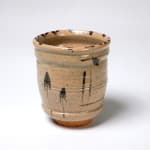Okamoto Sakurei 岡本作礼
H10.6 x Dia9.3 cm
Further images
-
(View a larger image of thumbnail 1
)

-
(View a larger image of thumbnail 2
)

-
(View a larger image of thumbnail 3
)

-
(View a larger image of thumbnail 4
)

-
(View a larger image of thumbnail 5
)

-
(View a larger image of thumbnail 6
)

-
(View a larger image of thumbnail 7
)

-
(View a larger image of thumbnail 8
)

-
(View a larger image of thumbnail 9
)

-
(View a larger image of thumbnail 10
)

-
(View a larger image of thumbnail 11
)

-
(View a larger image of thumbnail 12
)

Sakurei Okamoto 岡本 作礼 was born in Karatsu City, Saga Prefecture in 1958. He began specializing in Karatsu ware in 1979, and is now one of the leading ceramic artists of Karatsu. His works go beyond simple reproductions of Karatsu styles from antique periods such as Edo, but instead thinks through the essence of pottery in an alchemic way by addressing the basic historic precedents of Japanese pottery tradition, which has its roots in Han and Tang dynasty China.
In Chinese tradition, the basis of the universe consists of the five elements: Wood, fire, earth, metal and water. Sakurei believes that pottery fundamentally emerges from the five elements: The wood used for the kiln (and its ash for the glaze), the kiln built from the earth; fire used for firing; metal as found in the minerals of the clay and glaze surfaces (such as the iron in e-karatsu painted surfaces), and water for elutriation and kneading the clay- softening the body of the clay to form the potter’s desired shape in their mind’s eye. Sakurei strives to maintain this fundamental process.
Sakurei is also a spiritual man, reflecting on Nature's esoterica, and of the violence and destructive potential of earth’s natural elements that constitute his clay works. Reflecting on the energy and relativity between these elements, and how they combine to create works of art that we hold in our hand. His work is a prayer and reflection of his acute awareness and perception of the world around him. The grand subject is thoughtfully articulated in his work, which spans functional wares from cups to vessels, all made in various Karatsu traditions such as E-karatsu. He brings these thoughts into everyday spaces.
There is a tension between the grandeur of his meditation in his work, and the aesthetic modesty and quiet grace of Sakurei’s functional Karatsu. It is truly a dignified instance of the spirit of Yakimono pottery.
He has been exhibited internationally and domestically, at Kakiden Gallery and others. His kiln is based at the end of a long and winding mountain path. Young and veteran potters visit his gallery alike.











